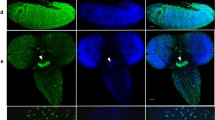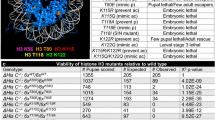Abstract
Relative amounts of various histone fractions in Drosophila chromatin were estimated densitometrically on electrophoretic gel separations. Several consistent and highly significant differences were obtained between larval and adult chromatin. The arginine-rich histones showed the most conspicuous changes: higher amounts of H4 in larvae, higher H3 in adults. The level of modification of these histones was clearly higher in larval than in adult chromatin. The modification of the two slower subfractions of H4 involved, in all probability, phosphorylation as well as acetylation. In all types of Drosophila chromatin studied 50% or more of the H2a molecules were phosphorylated—a remarkably high proportion. The species differences observed in relative amounts of histone were consistent in both stages of development. D. melanogaster differed from D. hydei and D. virilis in all histones except H2b, while the latter two species were generally similar. The interspecific variation in histone pattern was generally not correlated to differences in content of heterochromatin. The level of modification of H3 was, however, presumably an exception, as it was significantly lower for both larvae and adults in D. virilis than in the other two species. These differ from D. virilis in containing appreciably lower proportions of heterochromatic chromosome segments.
Similar content being viewed by others
References
Allfrey, V. G.: Functional and metabolic aspects of DNA-associated proteins. In: Histones and nucleohistones (D. M. P. Philips, ed.), p. 241–294. London and New York: Plenum Press 1971
Berendes, H. D., Keyl, H. G.: Distribution of DNA in heterochromatin and euchromatin of polytene nuclei of Drosophila hydei. Genetics 57, 1–13 (1967)
Bradbury, E. M.: Foreword: Histone nomenclature. Ciba Foundation Symp. 28, 1–4. Amsterdam: Assoc. Sci. Pub. 1975
Brown, S. W.: Heterochromatin. Science 151, 417–425 (1966)
Burton, K.: Determination of DNA concentration with diphenylamine. In: Methods of enzymology, 12, B (S. P. Colowick and N. O. Kaplan, eds.), p. 163–167. New York: Academic Press 1968
Chalkley, R., Hunter, C.: Histone-histone propinquity by aldehyde fixation of chromatin. Proc. nat. Acad. Sci. (Wash.) 72, 1304–1308 (1975)
Cohen, L. H., Gotchel, B. V.: Histones of polytene and nonpolytene nuclei of Drosophila melanogaster. J. biol. Chem. 246, 1841–1848 (1971)
Comings, D. E.: Histones of genetically active and inactive chromatin. J. Cell Biol. 35, 669–708 (1967)
Dickson, E., Boyd, J., Laird, C. D.: Sequence diversity of the polytene chromosome DNA from Drosophila hydei. J. molec. Biol. 61, 615–627 (1971)
Elgin, S. C. R., Boyd, J. B.: The proteins of polytene chromosomes of Drosophila hydei. Chromosoma (Berl.) 51, 135–145 (1975)
Fazekas de St. Groth, S., Webster, R. G., Datyner, A.: Two new staining procedures for quantitative estimation of proteins on electrophoretic strips. Biochim. biophys. Acta (Amst.) 71, 377–391 (1963)
Fleck, A., Munro, H. N.: The precision of ultraviolet absorption measurements in the Schmidt-Tannhauser procedure for nucleic acid estimation. Biochim. biophys. Acta (Amst.) 55, 571–583 (1962)
Frenster, J. H., Allfrey, V. G., Mirsky, A. E.: Repressed and active chromatin isolated from interphase lymphocytes. Biochemistry (Wash.) 50, 1026–1032 (1963)
Gall, J. G., Cohen, E. H., Polan, M. L.: Repetitive DNA sequences in Drosophila. Chromosoma (Berl.) 33, 319–344 (1971)
Gay, H.: Organization of chromosomes in higher forms. Carnegie Inst. Wash., Yearb. 64, 539–551 (1965)
Gottesfeld, J. M., Garrard, W. T., Bagi, G., Wilson, R. F., Bonner, J.: Partial purification of the template-active fraction of chromatin: A preliminary report. Proc. nat. Acad. Sci. (Wash.) 71, 2193–2197 (1974)
Gurley, L. R., Walters, R. A., Tobey, R. A.: The metabolism of histone fractions. 6. Differences in the phosphorylation of histone fractions during the cell cycle. Arch. Biochem. Biophys. 154, 212–218 (1973)
Harris, S. E., Forrest, H. S.: Template properties of embryo chromatin from eggs of the milkweed bug, Oncopeltus fasciatus. Develop. Biol. 23, 324–343 (1970)
Hennig, W.: Highly repetitive DNA sequences in the genome of Drosophila hydei. 1. Preferential localization in the X chromosomal heterochromatin. J. molec. Biol. 71, 407–417 (1972a)
Hennig, W.: Highly repetitive DNA sequences in the genome of Drosophila hydei. 2. Occurrence in polytene tissues. J. molec. Biol. 71, 419–431 (1972b)
Hnilica, L. S.: The structure and biological functions of histones. Cleveland: CRC Press. 1972
Johmann, C., Eckhardt, R. A., Gorovsky, M. A.: The histones associated with condensed and extended chromatin of mouse liver. J. Cell Biol. 58, 119–125 (1973)
Johns, E. W., Forrester, S.: Studies on nuclear proteins. The binding of extra acidic proteins to deoxyribonucleoprotein during the preparation of nuclear proteins. Europ. J. Biochem. 8, 547–551 (1969)
Johnson, A. W., Hnilica, L. S.: In vitro RNA synthesis and nuclear proteins of isolated sea urchin embryo nuclei. Biochim. biophys. Acta (Amst.) 224, 518–530 (1970)
Kornberg, R. D.: Chromatin structure: A repeating unit of histones and DNA. Science 184, 868–871 (1974)
Krause, M. O., Yoo, B. Y., Macheath, L.: Histones from exponential and stationary L-cells. Arch. Biochem. Biophys. 164, 172–178 (1974)
Laird, C. D., Chooi, W. Y., Cohen, E. H., Dickson, E., Hutchinson, N., Turner, S. H.: Organization and transcription of DNA in chromosomes and mitochondria of Drosophila. Cold Spr. Harb. Symp. quant. Biol. 38, 311–327 (1974)
Lowry, O. H., Rosebrough, N. J., Farr, A. L., Randall, R. J.: Protein measurement with the Folin phenol reagent. J. biol. Chem. 193, 265–275 (1951)
Martinson, H. G., McCarty, B. J.: Histone-histone association within chromatin. Crosslinking studies using tetranitromethane. Biochemistry 14, 1073–1078 (1975)
Marzluff, W. F. Jr., McCarty, K. S.: Two classes of histone acetylation in developing mouse mammary gland. J. biol. Chem. 245, 5635–5642 (1970)
McMaster-Kaye, R., Kaye, J. S.: An electrophoretic analysis of the histones of the house cricket. Arch. Biochem. Biophys. 156, 426–436 (1973)
Oliver, D., Chalkley, R.: An electrophoretic analysis of Drosophila histones. 1. Isolation and identification. Exp. Cell Res. 73, 295–302 (1972a)
Oliver, D., Chalkley, R.: An electrophoretic analysis of Drosophila histones: 2. Comparison of larval and adult histone patterns in two species of Drosophila. Exp. Cell Res. 73, 303–310 (1972b)
Oliver, D., Sommer, K. R., Panyim, S., Spiker, S., Chalkley, R.: A modified procedure for fractionating histones. Biochem. J. 129, 349–353 (1972)
Panyim, S., Bilek, D., Chalkley, R.: An electrophoretic comparison of vertebrate histones. J. biol. Chem. 246, 4206–4215 (1971)
Panyim, S., Chalkley, R.: High reolution acrylamide gel electrophoresis of histones. Arch. Biochem. Biophys. 130, 337–346 (1969a)
Panyim, S., Chalkley, R.: The heterogeneity of histones. 1. A quantitative analysis of calf histones in very long polyacrylamide gels. Biochemistry 8, 3972–3979 (1969b)
Peacock, W. J., Brutlag, D., Goldring, E., Appels, R., Hinton, C. W., Lindsley, D. L.: The organization of highly repeated DNA sequences in Drosophila melanogaster chromosomes. Cold Spr. Harb. Symp. quant. Biol. 38, 405–416 (1974)
Rae, P. M. M.: The distribution of repetitive DNA sequences in chromosomes. Advanc. Cell molec. Biol. (N.Y.) 2, 109–149 (1972)
Rudkin, G. T.: Replication in polytene chromosomes. In: Developmental studies on giant chromosomes (W. Beermann, ed.), p. 58–85. Berlin-Heidelberg-New York: Springer 1972
Sin, Y. T.: Changes in basic proteins of chromatin during the larval development of the blowfly Calliphora, Insect Biochem. 3, 389–395 (1973)
Thomas, J. O., Kornberg, R. D.: An octamer of histones in chromatin and free in solution. Proc. nat. Acad. Sci. (Wash.) 72, 2626–2630 (1975)
Author information
Authors and Affiliations
Rights and permissions
About this article
Cite this article
Holmgren, P., Rasmuson, B., Johansson, T. et al. Histone content in relation to amount of heterochromatin and developmental stage in three species of Drosophila . Chromosoma 54, 99–116 (1976). https://doi.org/10.1007/BF00292833
Received:
Accepted:
Issue Date:
DOI: https://doi.org/10.1007/BF00292833




